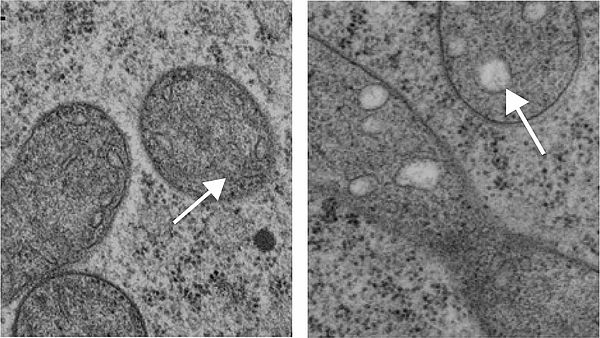Mitochondria
Multicellular organisms are energized by numerous often highly dynamic cellular organelles, termed mitochondria.
On a weight basis, a single mitochondrion converts "between 10,000 and 50,000 times more energy per second than the sun." (1)
Apart from their impressive role in energy production, mitochondria are involved in various cellular processes including Ca2+ signaling, redox homeostasis and the regulation of programmed cell death (2).
Mitochondrial Codes and Communication

Mitochondria-associated diseases
In humans, mitochondria-associated diseases are among the most common inherited genetic disorders (3). Examples include diabetis, cancer, neurodegenerative and cardiovascular diseases (4-7). Recently, mitochondria have been implicated in the regulation of sleep (8), further emphasizing the great significance of these minute organelles.
Past research has mainly focused on mitochondria in their entity. However, several studies have reported on remarkable mitochondrial heterogeneity both, among and within cells. The biological significance of this differences is not well understood, which is to a large extend due to technical limitations associated with the analysis of mitochondria at the single cell or even single mitochondrion level.

Regulation of cellular lifespan
We found that the cysteinyl-tRNA synthetase SYCO is expressed in the central cell, which is the precursor of the embryo nourishing tissue, but absent from the adjoining antipodal cells, which exhibit an extended lifespan in syco mutants. SYCO localizes to the mitochondria and ultrastructural analysis of mutant central cells revealed that the protein is necessary for mitochondrial cristae integrity. Furthermore, a dominant ATP/ADP translocator caused mitochondrial cristae degeneration and extended antipodal lifespan when expressed in the central cell of wild-type plants. Notably, this construct did not affect antipodal lifespan when expressed in antipodals. Our results thus identified an unexpected noncell autonomous role for mitochondria in the regulation of cellular lifespan and draw the attention away from the dying cell and toward adjacent nondying cells as a potential cause for Programmed Cell Death (PCD) (Kägi et al. 2010).
References
- Schatz, G. The Magic Garden. Annual Review of Biochemistry 76, 673-678 (2007).
- A. V. Kuznetsov, R. Margreiter, Heterogeneity of mitochondria and mitochondrial function within cells as another level of mitochondrial complexity. Int J Mol Sci 10, 1911-1929 (2009).
- R. N. Lightowlers, R. W. Taylor, D. M. Turnbull, Mutations causing mitochondrial disease: What is new and what challenges remain? Science 349, 1494-1499 (2015).
- S. B. Ong et al., Inhibiting mitochondrial fission protects the heart against ischemia/reperfusion injury. Circulation 121, 2012-2022 (2010).
- P. H. Reddy et al., Dynamin-related protein 1 and mitochondrial fragmentation in neurodegenerative diseases. Brain Res Rev 67, 103-118 (2011).
- M. Williams, M. C. Caino, Mitochondrial Dynamics in Type 2 Diabetes and Cancer. Front Endocrinol (Lausanne) 9, 211 (2018).
- Y. Yoon, C. A. Galloway, B. S. Jhun, T. Yu, Mitochondrial dynamics in diabetes. Antioxid Redox Signal 14, 439-457 (2011).
- L. Melhuish Beaupre, Gregory M. Brown (2022) Mitochondria’s role in sleep: Novel insights from sleep deprivation and restriction studies, The World Journal of Biological Psychiatry, 23:1, 1-13, DOI: 10.1080/15622975.2021.1907723
